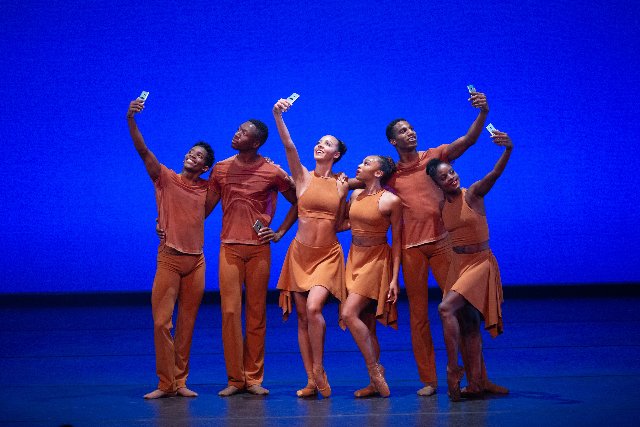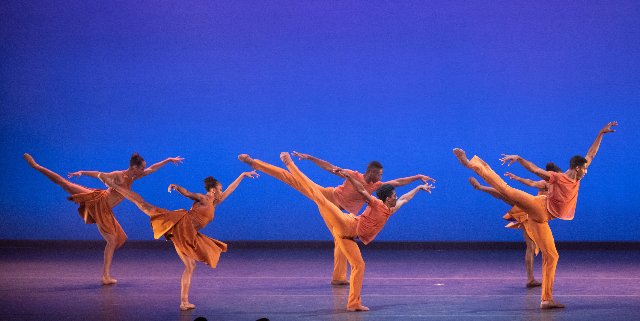Jacob’s Pillow 2024 Season Ends
Dance Theatre of Harlem
By: Charles Giuliano - Aug 26, 2024
Dance Theatre of Harlem
Ted Shawn Theatre|Jacob’s Pillow
August 21-25, 2024
Founders, Arthur Mitchell, Karel Shook
Artistic Director, Robert Garland
Dancers: Ariana Dickinson, Lindsey Donnell, Carly Greene, Alexandra Hutchinson, Alexandra Rene Jones, Michaela Martin-Mason, Kira Robinson, Kamala Saara, Ingrid Silva, Delaney Washington, Stephanie Rae Williams, Derek Brackington, Micah Bullard, Kauadio Davis, Keenah English, Elias Re, Luis Fernando Rego, Joshuan Vazquez, David Wright
Higher Ground (2022)
Choreography, Robert Garland
Costumes, Pamela Allen-Cummings
Lighting, Roma Flowers
Music, Stevie Wonder
”Look Around,” “We Have Done Nothin,” “Heaven Is Ten Zillion Light Years Away,” “Village Ghetto Land,” “Saturn,” “Higher Ground.”
Take Me With You (2024)
Choreography, Robert Bandara
Lighting and Costumes, Robert Bandara
Music by Radio Head
Allegro Brilliante (1956)
Choreography, George Balanchine
Music, Peter Ilyich Tchaikovsky
Costumes, Kathy A. Freeman
Lighting recreated by Katy A. Freeman
Blake Works IV
(The Barre Project, 2023)
Choreography, William Forsyth
Music, James Blake
Costumes, William Forsyth, Katy A. Freeman|
Original sound, Benjamin Young
Lighting, Brandon Stirling Baker
Yesterday we attended a performance of Dance Theatre of Harlem which concluded the nine week, 2024 Jacob’s Pillow Season. Yet again artistic director, Pamela Tatge, created a stunning festival of world renowned companies.
Next summer promises to be even bigger with the relaunch of the renovated and expanded Doris Duke Theater. Pillow will be back at full strength with three stages.
Ted Shawn invited Dance Theater of Harlem to perform in 1970. It was the renowned company’s first professional engagement. It was founded by Arthur Mitchell and Karel Shook on the premise of providing training and careers to young dancers of color. The classical ballet of George Balanchine was a cornerstone of that mandate.
The company became established but faced adversity. It was disbanded from 2004 to 2013. When reformed it trimmed its 30 plus dancers to the current eleven. That also means developing a new repertory of more intimate dances. There was also the disruption of Covid which DTH addressed with very successful Zoom streaming.
In the past year there has been a change of artistic director. The challenge for Robert Garland has been to retain the strengths of the company, its depth in traditional ballet training, as well as embracing fresh work and emerging shifts.
Toward that end Garland curated a balanced program for his Pillow debut as artistic director of a company with a renowned legacy.
The performance began with Garland’s 2022 work for six dancers, Higher Ground. It is set to a suite of Stevie Wonder’s “social justice” themed songs ”Look Around,” “We Have Done Nothin,” “Heaven Is Ten Zillion Light Years Away,” “Village Ghetto Land,” “Saturn,” “Higher Ground.”
Dressed in the casual tan costumes of Pamela Allen-Cummings the choreography was fresh, accessable and enjoyable. The first two dances entailed circling and partnering. As the work evolved there were pas de deux and solo elements. While rooted in social dance there were elements performed en pointe. This was a seamless element of the movement vocabulary and did not call attention to itself. The stylistic transitions seemed entirely fluid and natural.
Given the lyrics and nature of the six songs there were changes that disrupted a sense of continuity. There were adjustments to these shifts. It all came together with poignant, otherworldly resonance in “Heaven Is Ten Zillion Light Years Away.” The suite ended as a raucous romp to the infectious, complex, polyrhythm of the familiar “Higher Ground.”
Wearing black briefs and a loose white shirt tied at the waist, Lindsey Donnell appeared on stage setting a beat by clapping her hands. She was joined by the similarly attired Elias Re. They eased into an intricate and sharply executed pas de deux “Take Me With You” set to a Radiohead song by Robert Bandara. It was brief, incisive, and left one hungry for more. It lingered enticingly as Donnell slithered off again while clapping a beat.
For me, Balanchine’s familiar Allegro Brillante was the highlight of the program. It featured the stunning pair of Ingrid Silva and Keenan English. They were backed by four pairs of dancers. The work displayed the flawless command of ballet technique set to Balanchine’s iconic choreography. The company is committed to retaining and expanding this mandate. Back in 1970 there was a social justice point to be made while today it is sustaining a connection to an important and viable legacy.
Arguably, William Forsyth’s ambitious, avant-garde “Black Works IV, the Barre Project” brings us up to speed with the ever evolving company. It was originally created during the pandemic and streamed on line. Set to the stutter step, dissonant, and at time annoying sound/ music of James Blake it is a challenging work. It’s dissected into many increments with sound and mood shifts. At times we hear what appears to be a hammer clanging on steel. This interacts with the jerky movements synched with the odd and off putting sound.
The barre is set at the back of the stage. In many configurations the dancers hold it as they would be supported in a rehearsal studio. Their movement, however, is quite independent with no apparent need for holding on. So the barre is a metaphor and prop.
The program left us with an overview of the company and its rich, complex legacy. We much anticipate where Garland will take it from here.




